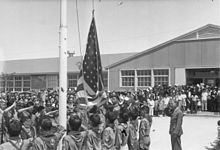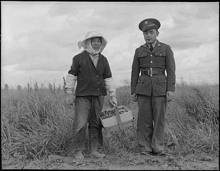- Japanese-American service in World War II
-
 Boy Scouts at Granada War Relocation Center raising flag to half-mast during a Memorial Service for first six Nisei soldiers from this Center who were killed in action in Italy. The service was attended by 1500 Amache internees. -- August 5, 1944.
Boy Scouts at Granada War Relocation Center raising flag to half-mast during a Memorial Service for first six Nisei soldiers from this Center who were killed in action in Italy. The service was attended by 1500 Amache internees. -- August 5, 1944.
During the early years of World War II, Japanese Americans were forcibly relocated from their homes in the Pacific coast states because military leaders and public opinion combined to fan unproven fears of sabotage. As the war progressed, many of the young Nisei, Japanese immigrants' children who were born with American citizenship, volunteered to serve in the United States military.
Contents
Servicemen in the U.S. Army
 A soldier and his mother in Florin, Sacramento County, California[1]
A soldier and his mother in Florin, Sacramento County, California[1]
The majority of Japanese Americans serving in the American armed forces during World War II enlisted in the army.
100th Infantry Battalion
The Japanese-American 100th Infantry Battalion was engaged in heavy action during the war taking part in multiple campaigns. The 100th battalion was made up of Nisei from Hawaii originally a part of the Hawaii National Guard. Their exemplary military record and the patriotism established by the Varsity Victory Volunteers paved the way for the creation of the 442nd Regimental Combat Team, which was also an all-Nisei force.[2]
442nd Regimental Combat Team
The Japanese-American 442nd Regimental Combat Team was an all-Nisei U.S. Army regiment which served in Europe during World War II. The 442nd arrived in Europe after the 100th Infantry battalion had already established its reputation as a fighting unit. In time, the 442nd became, for its size and length of service the most decorated unit in U.S. military history.[2]
522nd Field Artillery Battalion
The all-Nisei 522nd Field Artillery Battalion was organized as part of the 442nd Regimental Combat Team; but towards the end of the war, the 522nd became a roving battalion, shifting to whatever command most needed the unit.[3] The 522nd had the distinction of liberating survivors of the Dachau concentration camp system, from the Nazis on April 29, 1945.[2] Nisei scouts west of Munich near the small Bavarian town of Lager Lechfeld encountered some barracks encircled by barbed wire. Technician Fourth Grade Ichiro Imamura described it in his diary:
- "I watched as one of the scouts used his carbine to shoot off the chain that held the prison gates shut .... They weren’t dead, as he had first thought. When the gates swung open, we got our first good look at the prisoners. Many of them were Jews. They were wearing striped prison suits and round caps. It was cold and the snow was two feet deep in some places. There were no German guards. The prisoners struggled to their feet .... They shuffled weakly out of the compound. They were like skeletons - all skin and bones ...."[3]
Holocaust historians have clarified that the Nisei 522nd liberated about 3,000 prisoners at Kaufering IV Hurlach. Hurlach was one of 169 subordinate slave labor camps of Dachau. Dachau, like Auschwitz, Buchenwald, Mauthausen and Ravensbrück, was surrounded by hundreds of sub-camps.[3]
Pierre Moulin in his recent book 'Dachau, Holocaust and US Samurais' writes that the first Nisei arrived at Dachau's gate not on April 29, the date of the liberation of the camp, but on April 28, 1945.[4]
Servicemen in the Army Air Force
Japanese Americans were generally forbidden to fight a combat role in the Pacific theatre; although no such limitations were placed on Americans of German or Italian ancestry who fought against the Axis Powers. Up to this point, the United States government has only been able to find records of five Japanese Americans who were members of the Air Corps during World War II, one of them being Kenje Ogata. There was at least one Nisei, U.S. Army Air Force Technical Sergeant Ben Kuroki, who participated in 28 bombing missions over mainland Japan and other locations.[5]
Military Intelligence Service
Approximately 6,000 Japanese Americans served in the Military Intelligence Service (MIS), most of which were attached to the Allied Translator and Interpreter Section (ATIS) as linguists and in other non-combatant roles, interpreting captured enemy documents and interrogating prisoners of war. The initial training facility to prepare for their function was at Camp Savage in Savage, Minnesota. This decision was to locate them in a region where there was less racial prejudice towards the Japanese as compared to the West Coast.
Japanese-American MIS linguists translated Japanese documents known as the "Z Plan", which contained Japan's counterattack strategy in the Central Pacific. This information led to Allied victories at the Battle of the Philippine Sea, in which the Japanese lost most of their aircraft carrier planes, and the Battle of Leyte Gulf. An MIS radio operator intercepted a message describing Admiral Isoroku Yamamoto's flight plans, which led to P-38 Lightning fighter planes shooting down his plane over the Solomon Islands.
Recognition
The nation's highest award for combat valor, the Medal of Honor, was conferred upon twenty-one members of the 100th Infantry battalion of the 442nd Regimental Combat Team of World War II. On October 5, 2010, the Congressional Gold Medal was awarded to the 442nd Regimental Combat Team and the 100th Infantry Battalion, as well as the 6,000 Japanese Americans who served in the Military Intelligence Service during the war.[6]
References
- ^ The full caption from the original photo:Florin, Sacramento County, California. A soldier and his mother in a strawberry field. The soldier, age 23, volunteered July 10, 1941, and is stationed at Camp Leonard Wood, Missouri. He was furloughed to help his mother and family prepare for their evacuation. He is the youngest of six years children, two of them volunteers in United States Army. The mother, age 53, came from Japan 37 years ago. Her husband died 21 years ago, leaving her to raise six children. She worked in a strawberry basket factory until last year when her children leased three acres of strawberries "so she wouldn't have to work for somebody else". The family is Buddhist. This is her youngest son. Her second son is in the army stationed at Fort Bliss. 453 families are to be evacuated from this area. カリフォルニア州サクラメント郡フローリン。いちご畑にて兵士と母。兵士は23歳、1941年7月10日に志願してミズーリ州レオナード・ウッド・キャンプに駐屯中。母と家族の強制退去を手伝うために休暇を取った。彼は6人兄弟の末っ子で、6人のうち2人が米国陸軍の志願兵となった。53歳の母親は37年前に日本から移民、夫を21年前に亡くし、6人の子どもを育て上げた。母親は昨年子どもたちが「もう母さんが他の人のために働かなくてもよいように」と3エーカーの苺畑をリースするまでずっと、苺バスケットの工場で働いてきた。家族は仏教徒。二番目の息子はフォート・ブリスの陸軍基地にいる。写真の地域から453世帯が強制立ち退きさせられた。
- ^ a b c "Terminology and Glossary," Denshō, The Japanese American Legacy Project.
- ^ a b c Go for Broke National Education Center: Central Europe Campaign, 522nd
- ^ Moulin, Pierre (2007). Dachau, Holocaust and US Samurais - Nisei Soldiers first in Dachau. Authorhouse Editions. ISBN 978-1-4259-3801-7.
- ^ Yenne, Bill. (2007). Rising Sons: The Japanese-American GIs Who Fought for the United States in World War II, p. 140.
- ^ Steffen, Jordan (October 6, 2010), "White House honors Japanese American WWII veterans", The Los Angeles Times, http://www.latimes.com/news/nationworld/nation/la-na-veterans-medal-20101006,0,7017069.story
- Asahina, Robert. (2007). Just Americans: How Japanese American Won a War at Home and Abroad. New York: Gotham Books. ISBN 978-1-592-40300-4
- Sterner, C. Douglas. (2007). Go for Broke: The Nisei Warriors of World War II Who Conquered Germany, Japan, and American Bigotry, Clearfield, Utah: American Legacy Media. 10-ISBN 0-979-68961-9; 13-ISBN 978-0-979-68961-1 OCLC 141855086
- Yenne, Bill. (2007). Rising Sons: The Japanese American GIs Who Fought for the United States in World War II. New York: Macmillan. 10-ISBN 0-312-35464-9; 13-ISBN 978-0-312-35464-0
- Moulin, Pierre. (1993). U.S. Samurais in Bruyeres - People of France and Japanese Americans: Incredible story Hawaii CPL Editions. ISBN 2-9599984-05 [1]
- Moulin, Pierre. (2007). Dachau, Holocaust and US Samurais - Nisei Soldiers first in Dachau Authorhouse Editions. ISBN 978-1-4259-3801-7 [2]
Further reading
- McNaughton, James (2006). Nisei Linguists:Japanese Americans in the Military Intelligence Service during World War II. Washington, D.C.: United States Army Center of Military History. CMH Pub 70-99-1. http://www.history.army.mil/html/books/nisei_linguists/index.html.
United States in World War II Home Front American music during World War II • United States aircraft production during World War II • Greatest Generation
American WomenWomen Airforce Service Pilots • Women's Army Corps• Woman's Land Army of America • Rosie the RiveterMilitary participation Army (Uniforms) • Army Air Force • Marine Corps • Navy • Service medals (Medal of Honor recipients)
EventsList of Battles • Attack on Pearl Harbor • Normandy landings • Atomic bombings of Hiroshima and NagasakiMinoritiesDiplomatic participation Categories:- American people of Japanese descent
- Japanese-American history
- American military personnel of Japanese descent
- United States Air Force airmen
- American military personnel of World War II
- People from Nebraska
Wikimedia Foundation. 2010.
